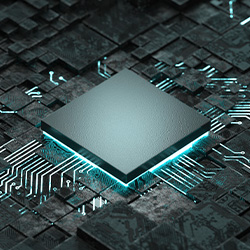Everyone enjoys a PC refresh - Processor performance joined by security as an important factor
The continued shift to hybrid work (and play) marked a significant departure from pandemic norms. While health protocols reverted, the digital realm saw enduring changes. Amidst this transformation, security has emerged as a crucial but often overlooked aspect of personal and business computing, joining (speed) processor power as a significant factor in users upgrading PCs.
And, despite the recent passing of co-founder Gordon Moore, Intel has continued to advance in its approach to innovation, including prioritization of attributes like security and efficiency, which speak to the needs of modern computing.
Hardware evolves for our new hybrid reality
Looking back, PC sales surged during the peak of COVID restrictions in 2020 and 2021.1 They saw a significant decline by 13.7% in 2022 and the first half of 2023 as restrictions eased, according to International Data Corporation data from August 2023.
This post-COVID normalization of PC sales may have served to mask a notable transformation underway in the form of hardware-based threat detection. For the past several years, business PCs have shipped with Intel Threat Detection Technology (Intel TDT), providing an added layer of security. This enhanced protection may already be integrated into your endpoint security software, which when paired with an Intel vPro powered machine can deliver an effective hardware plus software solution, helping to keep you safe from advanced threats.
Why boost security from the silicon layer?
Enabling security directly from the silicon layer adds a hardware ‘eye’ for malicious payloads like cryptomining and ransomware by applying AI to low-level silicon data for runtime threat execution monitoring. Intel is the world’s only chipmaker that has developed the capability to enable CPU-level telemetry to assist endpoint security software from leading vendors.
In order to avoid potential strain on computing resources from AI computations, Intel’s optimization of Intel TDT can shift compute-intensive workloads from the CPU to the integrated GPU, allowing threat detection to operate at high performance, while ensuring little to no impact on the end user’s other critical tasks. Integration with endpoint security software like ESET PROTECT also allows for shared detections, enhancing security for PC fleets.
When coupled with modern endpoint software like ESET PROTECT, recognized for its low impact on performance, low false positives rates, and multi-layered technology fed by industry-leading malware and threat research, security receives an immediate boost. While PC fleets with integrated security are becoming increasingly widespread in 2024, the ongoing demand for compute power highlights that security remains a journey, especially in the context of the demanding hybrid work model, which introduces new threats and demands for both processor power and efficiency.
Powering integrated security
Intel engineers aim to establish collective security through Intel TDT’s integration with leading security software vendors, delivering scalable protections primarily tailored for business fleets. ESET, with millions of business endpoints in the SMB segment alone, integrated Intel TDT with ESET PROTECT in March 2022 via ESET Endpoint Security. This integration allows the ESET detection engine to co-validate threats with Intel TDT, leveraging ESET’s telemetry and both protection and prevention capabilities, and simultaneously ensuring high efficacy security without compromising system performance.
The collaboration extends from select 9th Gen Intel® Core™ processors to the latest Intel® Core™ Ultra processors, leveraging improved hardware telemetry capabilities in Intel’s processors for enhanced threat monitoring. These enhanced detections leveraging TDT’s CPU telemetry + AI-based technology and ESET Endpoint Security provide an additional layer of security for SMBs, augmenting ESET’s multilayered security solution without requiring additional micromanagement by security admins.
Hybrid work demands performance, efficiency, and security
Hybrid work necessitates steady advances in performance, efficiency, and security, which means that Moore’s Law remains relevant in supporting these demands, particularly with hardware-based security. While updates to processors still prioritize performance, there’s a noticeable shift toward deploying multicore solutions with distinct cores built for performance and those built for power efficiency.
In March 2023, IDC recognized Intel’s success in advocating for a PC refresh to enhance the end-user experience, elevate remote management capabilities, and establish a layered defense between hardware and software2 via Intel TDT. Furthermore, this alignment with modern work methods, such as hybrid work arrangements and online collaboration, enhances productivity while keeping efficiency and security in mind, without a compromise.
Regarding security, IDC also highlights the effectiveness of Intel vPro’s hardware-based AI threat detection and silicon-based Windows 11 virtualization in improving detection efficacy while reducing a computer’s attack surface.
Conclusion: Securing hybrid work is influencing hardware and software providers
In conclusion, the integration of ESET PROTECT with Intel TDT reflects a collaborative shift in the cybersecurity landscape, offering opportunities for wider integration among hardware and software providers. IDC emphasizes that modern endpoint security extends beyond software products, encompassing collaboration among various stakeholders in the ecosystem. This collaborative approach is timely, given the evolving cybersecurity needs of hybrid work environments, collaboration tools, and cloud services.
While the holistic approach demonstrated by the ESET - Intel integration is delivering immediate value to ESET’s customers, it also underscores the importance of incorporating enhanced prevention and protection measures when refreshing PC fleets for hybrid work. ESET R&D teams are collaborating with Intel to leverage future generations of processors to ensure the best of hardware and software are working together to deliver robust security solutions.
1Forbes, July 10, 2020 – Gartner’s preliminary PC sales results for the second quarter of 2020 show huge gains for several of the leading PC makers, not least HP, which saw sales increase by 17.1% year-on-year to push the company within a whisker of reclaiming its spot as the world’s biggest maker. Lenovo clings to that title, shipping 16.197m units in the quarter to HP’s 16.165m.
2IDC, Quick Take, Can your PCs deliver the end-user experience, manageability, and security you need now and in the future?, #lcUS50531323; March 2023

